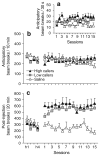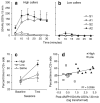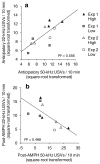Individual differences in the conditioned and unconditioned rat 50-kHz ultrasonic vocalizations elicited by repeated amphetamine exposure
- PMID: 23700082
- PMCID: PMC3935796
- DOI: 10.1007/s00213-013-3130-9
Individual differences in the conditioned and unconditioned rat 50-kHz ultrasonic vocalizations elicited by repeated amphetamine exposure
Abstract
Rationale: Adult rats often produce 50-kHz ultrasonic vocalizations (USVs), particularly the frequency-modulated varieties, in appetitive situations. These calls are thought by some to reflect positive affective states and the reinforcing value of drugs such as amphetamine and cocaine.
Objective: The objective of this study was to determine whether the number of unconditioned 50-kHz USVs elicited by amphetamine predicts the development and/or magnitude of drug-conditioned motivation.
Methods: In three experiments, we recorded USVs before and after injections of 1 mg/kg amphetamine (i.v. or i.p.) administered once per session. Rats were categorized as "high callers" or "low callers" according to individual differences in the number of 50-kHz USVs elicited by their first amphetamine injection. We examined the conditioned appetitive behavior and conditioned place preference (CPP) that emerged in high and low callers after repeated pairings of amphetamine with specific contexts. We also examined whether amphetamine-induced calling was affected by treatment within an unfamiliar (test chamber) versus familiar (home cage) context.
Results: Within an unfamiliar environment, the high callers consistently produced more amphetamine-induced 50-kHz USVs than the low callers. Compared to the low callers, high callers showed significantly greater amphetamine CPP as well as enhanced conditioned 50-kHz USVs and locomotor activity during anticipation of amphetamine. Individual differences were stable when amphetamine was administered in test chambers, but when it was administered in home cages, low callers showed an increase in 50-kHz calling that matched the high callers.
Conclusions: These findings suggest that individual differences in drug-induced USVs can reveal environment-sensitive traits involved in drug-related appetitive motivation.
Figures








References
-
- Amsel A. The role of frustrative nonreward in noncontinuous reward situations. Psychol Bull. 1958;55(2):102–119. - PubMed
-
- Anagnostaras SG, Schallert T, Robinson TE. Memory processes governing amphetamine-induced psychomotor sensitization. Neuropsychopharmacology. 2002;26(6):703–715. - PubMed
-
- Barbano MF, Cador M. Various aspects of feeding behavior can be partially dissociated in the rat by the incentive properties of food and the physiological state. Behav Neurosci. 2005;119:1244–1253. - PubMed
-
- Bardo MT, Rowlett JK, Harris MJ. Conditioned place preference using opiate and stimulant drugs: a meta-analysis. Neurosci Biobehav Rev. 1995;19:39–51. - PubMed
Publication types
MeSH terms
Substances
Grants and funding
LinkOut - more resources
Full Text Sources
Other Literature Sources

